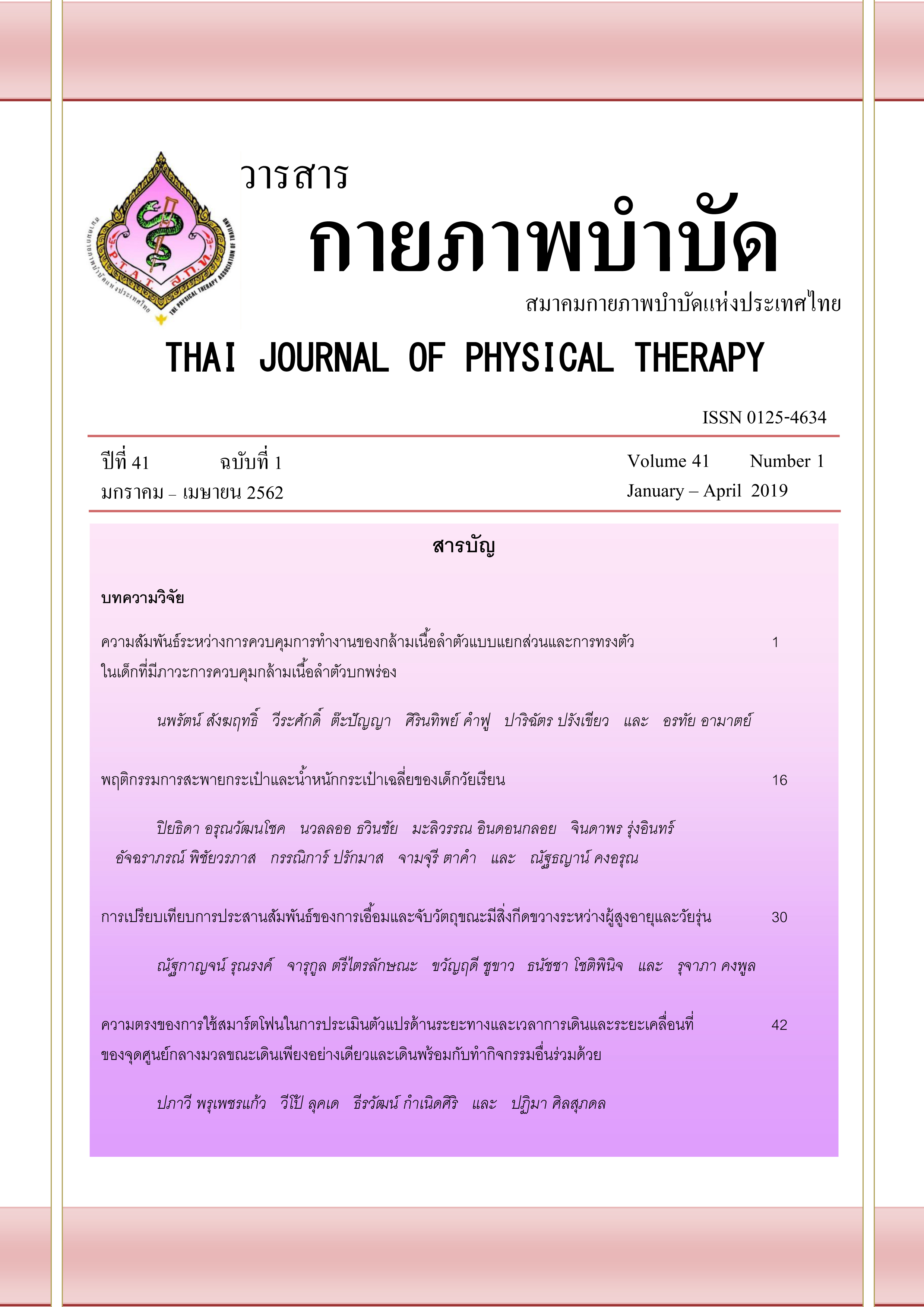ความตรงของการใช้สมาร์ตโฟนในการประเมินตัวแปรด้านระยะทางและเวลาการเดินและระยะเคลื่อนที่ของจุดศูนย์กลางมวลขณะเดินเพียงอย่างเดียวและเดินพร้อมกับทำกิจกรรมอื่นร่วมด้วย
Main Article Content
บทคัดย่อ
ที่มาและความสำคัญ: การพัฒนาเทคโนโลยีเพื่อประเมินการเดินในสิ่งแวดล้อมอิสระมีความจำเป็นอย่างยิ่ง โดยในปัจจุบันได้มีการนำสมาร์ตโฟนมาใช้ทางการแพทย์กันอย่างแพร่หลาย เนื่องจากราคาไม่แพง พกพาสะดวกและมีเซนเซอร์ที่สามารถนำมาใช้ทางการแพทย์ได้
วัตถุประสงค์: เพื่อศึกษาความตรงของเซนเซอร์วัดความเร่งบนสมาร์ตโฟนในการประเมินตัวแปรด้านระยะทางและระยะเวลาในการเดินและระยะเคลื่อนที่ของจุดศูนย์กลางมวลขณะเดินเพียงอย่างเดียวและเดินร่วมกับทำกิจกรรมต่างๆร่วมด้วย โดยอ้างอิงกับเครื่อง motion capture system
วิธีการวิจัย: คนหนุ่มสาวและผู้สูงอายุสุขภาพดี จำนวน 24 คน ได้รับการประเมินการเดินเป็นระยะทาง 10 เมตร ภายใต้เงื่อนไขเดินเพียงอย่างเดียวและเดินพร้อมกับทำกิจกรรมอื่นๆ ร่วมด้วยอีก 4 เงื่อนไข โดยประเมินความตรงจากตัวแปรการเดิน (เวลาก้าวเท้า ระยะก้าวเท้า ความเร็วในการเดิน อัตราการก้าวเท้าต่อนาที และระยะเคลื่อนที่ของจุดศูนย์กลางมวล) ที่คำนวณได้จากสมาร์ตโฟนและ motion capture system โดยใช้สถิติสัมประสิทธิ์สหสัมพันธ์แบบเพียร์สัน
ผลการวิจัย: เซนเซอร์วัดความเร่งบนสมาร์ตโฟนมีความตรงอยู่ในระดับสูงถึงสูงมากในการประเมินตัวแปรด้านการเดินทั้งขณะเดินเพียงอย่างเดียว (r = 0.789 - 0.990, p < 0.001) และเดินพร้อมกับทำกิจกรรมอื่นร่วมด้วย (r = 0.811 - 0.990, p < 0.001) และยังพบว่ามีความตรงอยู่ในระดับปานกลางเมื่อประเมินระยะเคลื่อนที่ของจุดศูนย์กลางมวลในแนวดิ่งขณะเดินเพียงอย่างเดียว (r = 0.563, p < 0.001) และอยู่ในระดับปานกลางถึงสูง (r = 0.588 -0.745, p < 0.001) ขณะเดินพร้อมกับทำกิจกรรมอื่นร่วมด้วย
สรุปผล: เครื่องวัดความเร่งบนสมาร์ตโฟนมีความตรงในการประเมินการเดินทั้งขณะเดินเพียงอย่างเดียวและเดินพร้อมกับทำกิจกรรมอย่างอื่นร่วมด้วย ดังนั้นอาจนำสมาร์ตโฟนมาใช้เพื่อประเมินการเดินในรูปแบบต่างๆ ทั้งในคลินิกและชุมชนได้ต่อไป
Article Details
References
2. Verghese J, Wang C, Lipton RB, Holtzer R, Xue X. Quantitative gait dysfunction and risk of cognitive decline and dementia. J Neurol Neurosurg Psychiatry. 2007;78:929-35.
3. Hirvensalo M, Rantanen T, Heikkinen E. Mobility difficulties and physical activity as predictors of mortality and loss of independence in the community-living older population. J Am Geriatr SO. 2000;48:493-8.
4. Maki BE. Gait changes in older adults: predictors of falls or indicators of fear. J Am Geriatr Soc. 1997;45:313-20.
5. Hardy SE, Perera S, Roumani YF, Chandler JM, Studenski SA. Improvement in usual gait speed predicts better survival in older adults. J Am Geriatr Soc. 2007;55:1727-34.
6. Studenski S, Perera S, Patel K, et al. Gait Speed and Survival in Older Adults. JAMA.2011;305:50-8.
7. Chou LS, Kaufman KR, Hahn ME, Brey RH. Medio-lateral motion of the center of mass during obstacle crossing distinguishes elderly individuals with imbalance. Gait Posture 2003;18:125–33.
8. Gutierrez EM, Bartonek A, Haglund-A kerlind V, Saraste H. Centre of mass motion during gait in persons with myelomeningocele. Gait Posture. 2003;18:37-46.
9. Furrer M, Bichsel L, Niederer M, Baur H, Schmid S. Validation of a smartphone-based measurement tool for the quantification of level walking. Gait Posture. 2015;42:289-94.
10. Kim A, Kim J, Rietdyk S, Ziaie B. A wearable smartphone-enabled camera-based system for gait assessment. Gait Posture. 2015;42:138-44.
11. Silsupadol P, Teja K, Lugade V. Reliability and validity of a smartphone-based assessment of gait parameters across walking speed and smartphone locations: Body, bag, belt, hand, and pocket. Gait Posture. 2017;58:516-22.
12. Hartmann A, Murer K, de Bie RA, de Bruin ED. Reproducibility of spatio-temporal gait parameters under different conditions in older adults using a trunk tri-axial accelerometer system. Gait Posture. 2009;30:351-55.
13. Kavanagh JJ, Menz HB. Accelerometry: a technique for quantifying movement patterns during walking. Gait Posture. 2008;28:1-15.
14. Agostini V, Lo Fermo F, Massazza G, Knaflitz M. Does texting while walking really affect gait in young adults? J Neuroeng Rehabil. 2015;12:86.
15. Lugade V, Lin V, Chou L. Center of mass and base of support interaction during gait. Gait Posture.2011;33:406-11.
16. Mukaka M. A guide to appropriate use of correlation coefficient in medical research. Malawi Med J.2012;24:69–71.
17. Lamberg EM, Muratori LM. Cell phones change the way we walk. Gait Posture. 2012;35:688-90.

